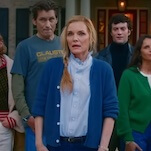It feels almost historic to read about the growth and reach of MySpace in an age where Facebook is widely seen to have pulled out a victory—which wasn’t necessarily the case when Wall Street Journal writer Julia Angwin began writing her first book, Stealing MySpace: The Battle To Control The Most Popular Website In America. But in terms of total traffic, Facebook is still catching up to MySpace in the U.S., even though as of April, it’s the most-visited social-networking site worldwide. Angwin holds off on the comparisons to explore the blood, sweat, and spam that went into MySpace’s creation.
MySpace began life as a Friendster competitor designed to save a flagging department at eUniverse, an Internet company best known for hawking dubious diet pills and downloadable cursors packaged with spyware. Chris DeWolfe and Tom Anderson (the “Tom” added to every new user’s profile), who had worked together at an e-mail marketing firm purchased by eUniverse, threw MySpace together so quickly that the code for new features was rarely tested before being unleashed on the public. Collaborations with indie bands, party photographers, and, yes, Tila Tequila contributed to its rise; where once its parent company, slow to respond to the site’s popularity, saw it mostly as a vehicle to direct traffic to its e-commerce outlets, it now boasted of MySpace’s success while CEO Richard Rosenblatt secretly engineered the sale of the company (now called Intermix) based on its unlikely flagship. This deal both rescued MySpace from its constricting superiors and attached it to an even larger corporate vehicle, for which it would turn out massive profits.
Angwin seems most comfortable when office anecdotes take a back seat to corporate maneuvering, but Stealing MySpace is at its most interesting when its business history illuminates its development—the option to customize pages, for example, was an early design flaw that the team only held off on fixing once they saw how popular it was. Meanwhile, in spite of appearances by Sumner Redstone and Rupert Murdoch, a chapter on Viacom and NewsCorp competing to purchase Intermix is dry enough to cast doubt on the heated negotiations and all-nighters depicted there.
And Angwin’s attempts to cast DeWolfe and Anderson as a scrappy band of outsiders seems to suggest that without the interference of the corporate stiffs, MySpace would still be without peer today. The team behind MySpace was no focus-group-sated bunch of suits, but given Rosenblatt’s behavior prior to the merger, the resources NewsCorp put within its designers’ reach may have been the best thing to happen to the site.








































